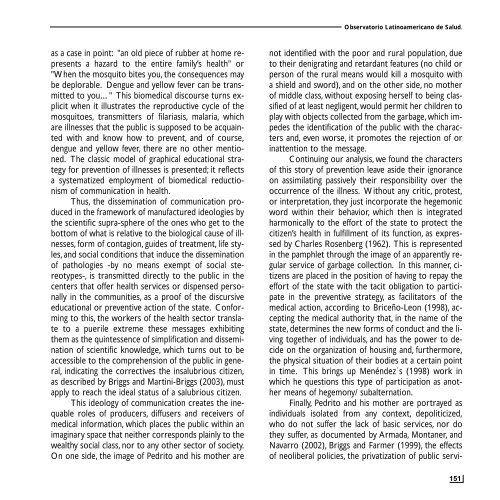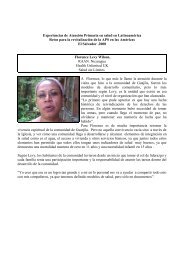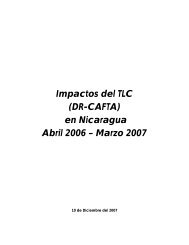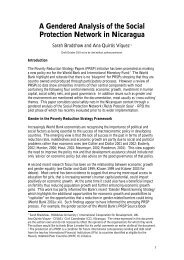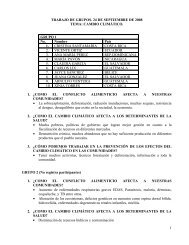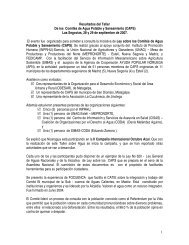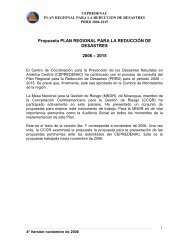Download - CISAS | Centro de Información y Servicios de AsesorÃa ...
Download - CISAS | Centro de Información y Servicios de AsesorÃa ...
Download - CISAS | Centro de Información y Servicios de AsesorÃa ...
Create successful ePaper yourself
Turn your PDF publications into a flip-book with our unique Google optimized e-Paper software.
Observatorio Latinoamericano <strong>de</strong> Salud.as a case in point: "an old piece of rubber at home representsa hazard to the entire family’s health" or"When the mosquito bites you, the consequences maybe <strong>de</strong>plorable. Dengue and yellow fever can be transmittedto you…" This biomedical discourse turns explicitwhen it illustrates the reproductive cycle of themosquitoes, transmitters of filariasis, malaria, whichare illnesses that the public is supposed to be acquaintedwith and know how to prevent, and of course,<strong>de</strong>ngue and yellow fever, there are no other mentioned.The classic mo<strong>de</strong>l of graphical educational strategyfor prevention of illnesses is presented; it reflectsa systematized employment of biomedical reductionismof communication in health.Thus, the dissemination of communication producedin the framework of manufactured i<strong>de</strong>ologies bythe scientific supra-sphere of the ones who get to thebottom of what is relative to the biological cause of illnesses,form of contagion, gui<strong>de</strong>s of treatment, life styles,and social conditions that induce the disseminationof pathologies -by no means exempt of social stereotypes-,is transmitted directly to the public in thecenters that offer health services or dispensed personallyin the communities, as a proof of the discursiveeducational or preventive action of the state. Conformingto this, the workers of the health sector translateto a puerile extreme these messages exhibitingthem as the quintessence of simplification and disseminationof scientific knowledge, which turns out to beaccessible to the comprehension of the public in general,indicating the correctives the insalubrious citizen,as <strong>de</strong>scribed by Briggs and Martini-Briggs (2003), mustapply to reach the i<strong>de</strong>al status of a salubrious citizen.This i<strong>de</strong>ology of communication creates the inequableroles of producers, diffusers and receivers ofmedical information, which places the public within animaginary space that neither corresponds plainly to thewealthy social class, nor to any other sector of society.On one si<strong>de</strong>, the image of Pedrito and his mother arenot i<strong>de</strong>ntified with the poor and rural population, dueto their <strong>de</strong>nigrating and retardant features (no child orperson of the rural means would kill a mosquito witha shield and sword), and on the other si<strong>de</strong>, no motherof middle class, without exposing herself to being classifiedof at least negligent, would permit her children toplay with objects collected from the garbage, which impe<strong>de</strong>sthe i<strong>de</strong>ntification of the public with the charactersand, even worse, it promotes the rejection of orinattention to the message.Continuing our analysis, we found the charactersof this story of prevention leave asi<strong>de</strong> their ignoranceon assimilating passively their responsibility over theoccurrence of the illness. Without any critic, protest,or interpretation, they just incorporate the hegemonicword within their behavior, which then is integratedharmonically to the effort of the state to protect thecitizen’s health in fulfillment of its function, as expressedby Charles Rosenberg (1962). This is representedin the pamphlet through the image of an apparently regularservice of garbage collection. In this manner, citizensare placed in the position of having to repay theeffort of the state with the tacit obligation to participatein the preventive strategy, as facilitators of themedical action, according to Briceño-Leon (1998), acceptingthe medical authority that, in the name of thestate, <strong>de</strong>termines the new forms of conduct and the livingtogether of individuals, and has the power to <strong>de</strong>ci<strong>de</strong>on the organization of housing and, furthermore,the physical situation of their bodies at a certain pointin time. This brings up Menén<strong>de</strong>z´s (1998) work inwhich he questions this type of participation as anothermeans of hegemony/ subalternation.Finally, Pedrito and his mother are portrayed asindividuals isolated from any context, <strong>de</strong>politicized,who do not suffer the lack of basic services, nor dothey suffer, as documented by Armada, Montaner, andNavarro (2002), Briggs and Farmer (1999), the effectsof neoliberal policies, the privatization of public servi-151


